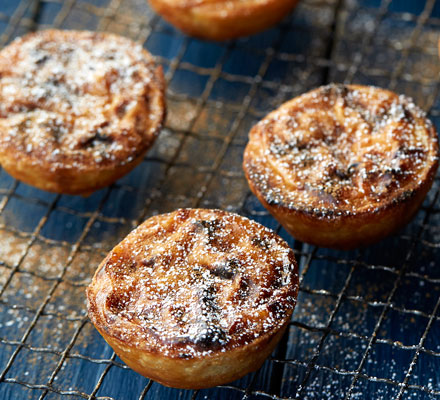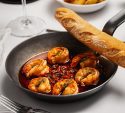Pastéis de nata (Portuguese custard tarts)
A classic Portuguese custard tart with buttery pastry and a hint of cinnamon and lemon in the filling. Who could resist these delicious tiny treats?
-
Prep:1 hrs
Cook:25 mins
plus 1 hr chilling - A challenge
Nutrition per serving
-
kcal 460
-
fat 22g
-
saturates 14g
-
carbs 58g
-
sugars 30g
-
fibre 1g
-
protein 3g
-
salt 0.1g
Ingredients
- 175g unsalted butter, plus extra, melted, for greasing
- 250g plain flour
- 225g caster sugar
- 1 cinnamon stick
- peel of ½ an unwaxed lemon
- 250ml milk
- 1 cinnamon stick
- peel of ½ an unwaxed lemon
- 20g unsalted butter
- 1 tsp cornflour
- 2 tbsp plain flour
- 2 organic egg yolks
Method
Using a pastry brush, grease eight individual pastry tins generously with the melted butter, then chill in the fridge. Put the butter between two sheets of baking parchment, then bash and roll into a large rectangle roughly the thickness of a £1 coin. In a large bowl, mix the flour with 150ml water and a pinch of salt using a wooden spoon. Tip the dough onto a clean surface and knead for 5 mins until smooth.
Shape the dough into a rough rectangle, cover with cling film and rest in the fridge for 20 mins. If your butter is getting too soft, put it in the fridge to chill too. Roll the dough out into a large, thin rectangle at least twice the size of the butter. Put the butter in the middle of the dough, fold all the edges up over it to encase it, then fold the dough over itself in half.
Roll out the dough to roughly half its original size, then fold in half, then half again to make a rectangle a quarter the size of the original. Repeat this process once more. Don’t worry about being too precise here, you’re just looking to create a few layers within the pastry. Cover and put the pastry in the fridge to rest for 20 mins.
Roll the chilled dough into a thin A3-sized rectangle, then roll it up lengthways into a tight sausage shape. Cut off a third for the tarts, then cover and freeze the rest for another time. (It would also make delicious palmier biscuits.)
Slice the pastry into 8 discs slightly thicker than a £1 coin. Work the discs into the tins with your fingers, pressing and stretching them to fill the tins. Chill while you make the custard.
In a pan, warm 150ml milk with the cinnamon stick, lemon peel and half the butter until just simmering and the butter has melted. In a large bowl, sieve the cornflour and flour into the remaining milk and whisk to form a thin paste. Pour the warm milk mixture over the flour paste and leave to infuse for a few mins. Sieve the custard back into the pan, heat gently and keep stirring for 3-4 mins until it reaches the consistency of double cream. Take off the heat and blend in the remaining butter.
Put the syrup ingredients in a pan and stir over a medium heat for 5 mins until you have a light, fragrant caramel. Take the pan off the heat and carefully pour in 150ml water. Return the pan to a low heat until the sugar has melted again into a syrup. Strain into a bowl.
Slowly add half the syrup to the custard and whisk until completely blended. You can store the custard in the fridge from this point, but don’t add the eggs until just before you are ready to cook the tarts. Heat oven to 260C/240C fan/gas 8. Put a baking tray on the top shelf of the oven to heat up. Whisk the egg yolks in a small bowl, then incorporate into the custard. Pour the mixture into the pastry tins, then place on the hot baking tray.
Put the tray at the bottom of the oven and bake for 5 mins. After 5 mins, turn the oven onto its grill setting and transfer the tarts to the top shelf. Grill for 2 mins until caramelised – the darker the better. Remove from the oven and brush with a little of the remaining syrup. Let the tarts cool slightly in the moulds before turning out onto a cooling rack.





















